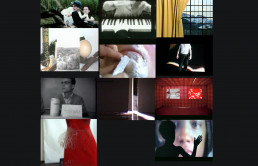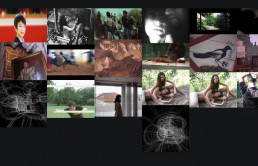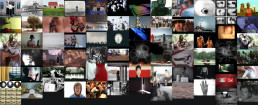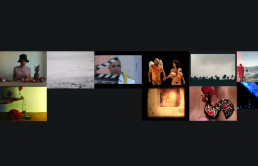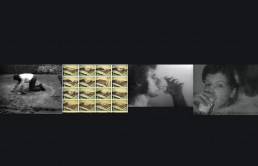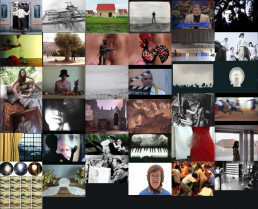FUSO 2010 – Programa 29 Julho, 22h
Goethe Institut
Tapes of friends that I still like
Uma seleção de Marcel Odenbach da coleção 40yearsvideoart, ZKM, Karlsruhe
Duração total da projeção 59’27’’
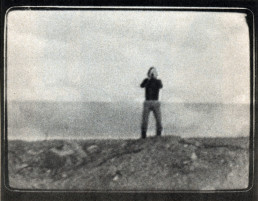
Jochen Gerz, Rufen bis zur Erschöpfung (To Cry Until Exhaustion), Alemanha, 1972, 19’30’’
Com esta videotape, Jochen Gerz está entre os primeiros artistas alemães a interessarem-se pelo medium vídeo. Nos anos que se seguem, realiza uma série de produções sobre o tema da autorreferência e reflexões sobre este medium. A sua primeira lendária videotape mostra, filmada no monitor que a exibe, as gravações de uma performance ao ar livre no campo, onde o artista, estando a 60 metros da câmara, grita continuamente “Hallo”, até que fica rouco e interrompe a performance.
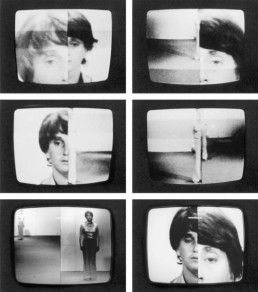
Valie Export, Raumsehen und Raumhören (Seeing Space and Hearing Space), Alemanha, 1974, 4’58’’
Como em Split Reality, a personalidade veiculada pelo medium nesta performance tape parece esquizofrénica. Duas câmaras de vídeo e uma mesa de mistura viabilizam uma ação em circuito fechado que demonstra, não só as diferenças no modo como os espectadores percecionam uma pessoa que está fisicamente presente na sala – e, simultaneamente, a sua reprodução eletrónica – mas também como a imagem é manipulada eletronicamente. A câmara através zoom in e zoom out, sujeita a aparência da performer no monitor a uma permanente alteração. Sons sintéticos específicos estão em link com a imagem – oticamente próximo = som de alta intensidade e uma repetição rápida do tom; oticamente remoto = som de baixo intensidade e uma repetição lenta do tom. O trabalho está organizado em seis partes: 1. posição no espaço, 2. imagens divididas, 3. composição de posição no espaço 4. composição de imagem dividida, 5. corpo, 6. composição de corpo.
Antes desta vídeo-performance ter sido apresentada na exposição Projekt 74 em Colónia, já tinha trabalhado questões que abordavam a perceção espacial no contexto da TV com Facing a Family (ORF, 1971), que confrontou a audiência de televisão com um reflexo de sua própria situação, bem como com a instalação Adjungierte Dislokationen (Adjusted Dislocations) de 1973.
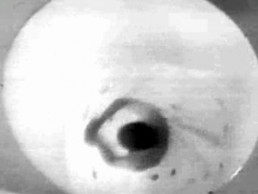
Ulrike Rosenbach, Tanz für eine Frau (Dance for One Woman), Alemanha, 1974, 8’
A artista roda em círculos para acompanhar a valsa Ich Tänze mit Dir in den Himmel Hinein (Eu vou Dançar Contigo para o Céu) até que cai. A perspetiva inclinada é obtida através dum espelho suspenso no teto. Desde 1972 que Ulrike Rosenbach produz continuamente videotapes, performances e instalações. Na instalação que criou para a Haus der Deutschen Geschichte, em Bona, Bilder der Frau aus der Nachkriegszeit (Imagens de Mulheres no Período Pós-Guerra), excertos de Tanz für eine Frau, entre outros trabalhos, são combinados com material de arquivo de modo a formar uma grande parede de monitores.
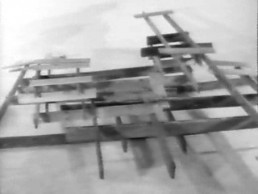
Jean-François Guiton, Holzstücke (Wood Pieces), Alemanha, 1982, 6’
O vídeo Holzstücke (Wood Pieces), o primeiro vídeo do artista, e, posteriormente, os vídeos Handle With Care (1984) e Fußnote (nota de rodapé) de 1985, provam até hoje que o método de trabalho de Guiton investiga as estruturas audiovisuais através da utilização de práticas de montagem em série e ritmadas.
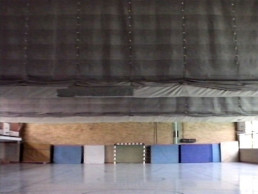
Dieter Kiessling, Vorhänge (Curtains), Alemanha, 1982-86, 1’30’’
O trabalho de investigação de Dieter Kiessling sobre as possibilidades do medium eletrónico em videotapes e instalações em circuito fechado, está ligado a um específico interesse conceptual: a exposição paralela de duas perspetivas, a abertura como fecho simultâneo em Vorhänge (Cortinas).
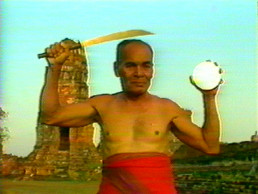
Marina Abramović & Ulay, City of Angels, Alemanha, 1983, 20’09’’
De 1975 a 1988, Marina Abramović e Ulay juntam-se, criando trabalhos artísticos, sobretudo, performances. As performances do início da década de 70, geralmente documentadas em vídeo ou filme, não foram concebidas para a câmara. Iniciam os primeiros trabalhos pensados especificamente como videotapes em 1983, com City of Angels, desenvolvida mais tarde para a Continental Video Series depois de fazerem viagens adicionais. “Para ter o momento o mais originário de uma cultura representada como um ser vivo,” escreve Ulay, os artistas começaram esta série de obras onde tentam evocar a essência de uma cultura através de uma representação simbólica do tempo, do lugar e do povo.
O “local sagrado” do metafórico City of Angels é o templo em ruínas de Ayutthaya, na Tailândia, onde, em poses como tableaux vivants, os tailandeses são capturados em imagens supernaturais de um drama visual espetacular. Presos em momentos de gesto ritual, esculpidos no tempo, eles são representados como seres icónicos que encarnam a memória e o espírito da cultura tradicional tailandesa, ao mesmo tempo vivos e mortos. Um texto ritual de Rama VI da Tailândia é o acompanhamento que assombra esta elegia cultural.
FUSO 2010 – Program July 29th, 10pm
Goethe Institut
Tapes of friends that I still like
Works selected by Marcel Odenbach from the collection 40yearsvideoart, ZKM, Karlsruhe
Total running time 59’27’’

Jochen Gerz, Rufen bis zur Erschöpfung (To Cry Until Exhaustion), Germany, 1972, 19’30’’
With this videotape Jochen Gerz was among the first German artists to concern himself with the video medium. Over the next years he realized a series of productions on the theme of self-reference and a medium’s reflection. Filmed off the monitor, his legendary first videotape shows the recordings of a performance in the open countryside where the artist, standing 60 meters away from the camera, keeps shouting ‘Hallo’ until he goes hoarse and breaks off the performance.

VALIE EXPORT, Raumsehen und Raumhören (Seeing Space and Hearing Space), Germany, 1974, 4’58’’
Like in Split Reality, the personality conveyed by a medium in this performance tape appears to be schizophrenic. Two video cameras and a mixer make possible a closed-circuit action that demonstrates not only the differences in the way the viewers perceive a person who is physically present in the room and simultaneously electronically reproduced, but also how the image is manipulated by its electronic conveyance. The camera zooms in and out, subjecting the performer’s monitor likeness to permanent alteration. Specific synthetic sounds are linked to the picture: optically close = loud sound and rapid tone repetition, optically remote = quiet sound and slow tone repetition. The work is arranged in six parts: 1. space position, 2. split images, 3. space position composition, 4. split image composition, 5. body, 6. body composition.
Before this performance video was documented at the Cologne exhibition Projekt 74, she had already worked with questions addressing spatial perception in the context of TV with Facing a Family (ORF, 1971), which confronted the TV audience at the time with a reflection of their own situation, as well as with the installation Adjungierte Dislokationen (Adjusted Dislocations) from 1973.

Ulrike Rosenbach, Tanz für eine Frau (Dance for One Woman), Germany, 1974, 8’
The artist turns in a circle to the accompaniment of the waltz Ich tanze mit Dir in den Himmel hinein (I’ll dance with you into Heaven) until she falls over. The tilted perspective is obtained by means of a mirror suspended from the ceiling.
Since 1972, Ulrike Rosenbach has continually produced videotapes, performances, and installations. In her documented installation created for the Haus der Deutschen Geschichte in Bonn, Bilder der Frau aus der Nachkriegszeit (Images of Women in the Postwar Period), excerpts from Tanz für eine Frau, among other works, are combined with archive material to form a large wall of monitors.

Jean-François Guiton, Holzstücke (Wood Pieces), Germany, 1982, 6’
“The various ‘wood pieces’ place the acoustic qualities of the banal procedures depicted on a level with the actual images, which show – in brief excerpts – the serially repeated collapse of various wood-plank constructions which were artfully built shortly beforehand. The restrained technical manipulation – confined to edits and running-speed alterations – matches the rhythm of visuals and sound in such a way that they take on a life of their own, intensifying to represent new perceptions.”
Jean-François Guiton
The video Holzstücke (Wood Pieces), the artist’s first videotape, and, following that, the videos Handle With Care (1984) and the 1985’s Fussnote (Footnote), prove up until today that Guiton’s ongoing working method investigates audiovisual structures through the use of serial and rhythmic montage practices.

Dieter Kiessling, Vorhänge (Curtains), Germany, 1982-86, 1’30’’
Dieter Kiessling’s research work on the possibilities of the electronic medium in videotapes and closed-circuit installations is linked to a specific conceptual interest, the parallel displaying of two perspectives – the opening up as a closing at the same time in Vorhänge (Curtains).

Marina Abramović & Ulay, City of Angels, Germany, 1983, 20’09’’
From 1975 to 1988, Marina Abramović and Ulay created some artistic works together, above all, in the form of performances. The early performances of the 1970s, usually documented on video or film, were not conceived for the camera. They began their first works meant specifically as videotapes in 1983, with City of Angels, later developed to the Continental Video Series after making additional trips. “To have the most original moment of a culture represented as a living being”, Ulay wrote, the artists began this series of works in which they attempted to evoke the essence of a culture through a symbolic representation of time, place, and people.
The “sacred site” for the metaphorical City of Angels is the ruined temple of Ayutthaya in Thailand, where, posed as tableaux vivants, Thai people are captured in supernatural images of striking visual drama. Arrested in moments of ritual gesture, sculpted in time, they are presented as iconic beings who embody the memory and spirit of traditional Thai culture, at once living and dead. A ritualistic text by Rama VI of Thailand is the haunting accompaniment to this cultural elegy.
